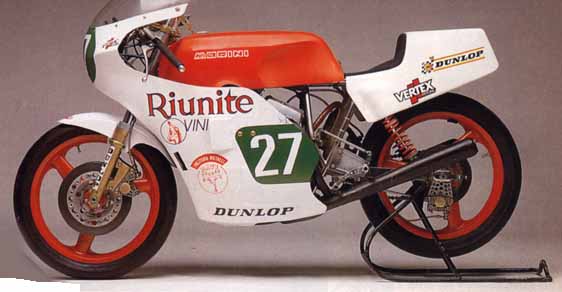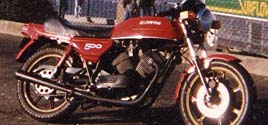This Model Began at the Wrecker's & Ended Up Winning the Italian TT3 Championship
Now It is on the Racetrack for the Battle of the Twins
(by Massimo Clarke, photos by Villani)
 The story of the Morini special told in this article is quite extraordinary and is worth telling in detail. The aim is to show what people on a limited budget can accomplish if they are guided by passion and possess skill and technical knowledge.
The story of the Morini special told in this article is quite extraordinary and is worth telling in detail. The aim is to show what people on a limited budget can accomplish if they are guided by passion and possess skill and technical knowledge.
Up to some years ago, junior racers were allowed to run only on production model or TT Formula bikes. With the aim of participating in the Italian 1981 TT3 championship (4 stroke up to 400 cc. and 2 stroke to 250 cc.), race-bike specialist Bruno Ruozzi from Reggio Emilia decided to produce a bike starting from a damaged Morini 3 1/2, that he had bought for a few hundred thousand lire (a few hundred dollars US). It was a brave decision and it went against the current of the times: the Benelli 2 stroke - 250 cc. twins were dominating the class.
With the help of a couple of dedicated friends, Ruozzi set readily to work. At the beginning there were only a few mechanical changes, but over time the transformation became so radical that, at the end of the project, really a very little of the original machine was left.
 After some early problems were solved, racing success followed. The bike won the Italian title in 1984 with the driver Andrea Perisi. The machine - which has been driven also by Romano Galeotti and Eros Manfredini - achieved two second places in two others years' championships in addition to the 1984 title. After a brief retirement - due to the disappearance of the TT3 class - the bike appeared again in Monza for the twins race held last July. The bike - driven once more by the brave Perisi - behaved very well in despite of the displacement difference (only 400 cc. against the 750, 851 and even 1000 cc. of the competitors). A second 420 cc. example of the bike has been produced.
After some early problems were solved, racing success followed. The bike won the Italian title in 1984 with the driver Andrea Perisi. The machine - which has been driven also by Romano Galeotti and Eros Manfredini - achieved two second places in two others years' championships in addition to the 1984 title. After a brief retirement - due to the disappearance of the TT3 class - the bike appeared again in Monza for the twins race held last July. The bike - driven once more by the brave Perisi - behaved very well in despite of the displacement difference (only 400 cc. against the 750, 851 and even 1000 cc. of the competitors). A second 420 cc. example of the bike has been produced.
This bike is based on a Morini 250 frame - lighter than the 3 1/2 one - that has been polished by Imerio Vizzani and varnished. The magnesium-alloy swingarm was a second-hand part, and the wheels (on the 400cc. version) are Marvic. The brakes up front are two front 270mm discs with Brembo two piston calipers (they cost much less than the four piston brakes!). Giving extraordinary attention to every detail and doing scrupulous lightening work, the dry weight has been kept at only 102kg.
The engine, fed by two Dellorto PHBH 32mm. carburettors, has been thoroughly modified around the heads: the inlet ports are now perfectly straight, and the valve seats and upper wall of the combustion chambers are made of bronze parts heat fixed in the heads.
 The valve guides have been shifted outwards and this, together with the increased bore to 66 mm, permitted mounting of much larger valves than original. (The inlet valves are 35mm. and the exhaust are 31mm. with just 6 mm. stems). The valve springs (with extra additional smaller internal springs) and rocker arms are original. Regarding the latter, there was a great deal of experimentation with eccentric bushes to change the ratio between the arms.
The valve guides have been shifted outwards and this, together with the increased bore to 66 mm, permitted mounting of much larger valves than original. (The inlet valves are 35mm. and the exhaust are 31mm. with just 6 mm. stems). The valve springs (with extra additional smaller internal springs) and rocker arms are original. Regarding the latter, there was a great deal of experimentation with eccentric bushes to change the ratio between the arms.
The camshaft is an L5 provided by Moto Morini. The tappets have been replaced with longer and lighter steel ones, and the pushrods are obtained from a VW Beetle!! The original pistons were replaced with SCIAMs featuring a different crown shape. The compression ratio is now over 12:1. The cylinders now have an integrated silicon carbon-nickel bore. A couple of cast-iron bores from a Renault 5 have also been used as well with very good results. The primary drive is stock but significantly lightened, the flywheel thickness has been more reduced by more than half and the bike has a highly modified clutch and gearbox (ratios are closer). Connecting rods and crankshaft are original but have been lightened and mirror polished. The exhaust ports are hand-polished and have the same length (the right duct is connected to the rear cylinder).
The engine has never been bench tested, but has a surprisingly wide usable range, from about 3000 to 10500 rpm. The maximum power is estimated to be about 50 HP, considering that the bike reaches 215 km/h and turns at the Misano racetrack in about 1'32''.
 We must mention the team that contributed to the enterprise: Gianni Iori, master mechanic, with his brother Emilio; Emilio Boschi the machinist; brothers Luigi and Wilmer Ruozzi together with their father Massimiliano. Among the sponsors we must mention Vertex pistons and Cantine Riunite (United Cellars and Wineshops) of Reggio Emilia who contributed in a substantial way to relieve the fatigue and worries of the team that distinguished himself, in addition to the value and ingeniousness of the project, by being one of the most good-humoured and hospitable of our junior-races paddocks.
We must mention the team that contributed to the enterprise: Gianni Iori, master mechanic, with his brother Emilio; Emilio Boschi the machinist; brothers Luigi and Wilmer Ruozzi together with their father Massimiliano. Among the sponsors we must mention Vertex pistons and Cantine Riunite (United Cellars and Wineshops) of Reggio Emilia who contributed in a substantial way to relieve the fatigue and worries of the team that distinguished himself, in addition to the value and ingeniousness of the project, by being one of the most good-humoured and hospitable of our junior-races paddocks.
